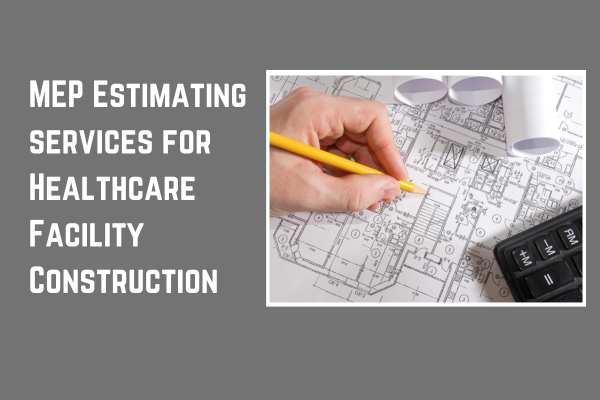The construction of healthcare facilities, including hospitals, clinics, and medical centers, requires an extraordinary level of attention to detail and precision. Every part of the building must be designed to meet specific regulations, standards, and functional needs. One of the most crucial components of healthcare facility construction is the mechanical, electrical, and plumbing (MEP) systems, which are vital for the day-to-day functioning of the facility.
For precision estimators, MEP estimating for healthcare facility construction involves a detailed and highly specialized process. It is crucial to ensure that the MEP systems are appropriately designed, properly installed, and accurately estimated to meet the requirements of the building and its future occupants. This article will explore the importance of MEP estimating Services in healthcare facility construction, the unique challenges that come with it, and how precision estimators can ensure the success of such projects.
The Importance of MEP Systems in Healthcare Facilities
The MEP systems in healthcare facilities are among the most critical infrastructure components. They not only ensure the building functions smoothly but also directly impact the safety, comfort, and well-being of patients, staff, and visitors. These systems include:
- Mechanical Systems (HVAC): Heating, ventilation, and air conditioning (HVAC) systems are essential in maintaining optimal temperature and air quality. Hospitals and clinics have specialized needs for HVAC systems due to the necessity for precise temperature control in various departments, such as operating rooms, intensive care units (ICUs), and laboratories.
- Electrical Systems: The electrical systems in healthcare facilities power vital medical equipment, lighting, backup generators, and other electrical infrastructure. They need to be designed with redundancy in mind to ensure that the power supply remains uninterrupted, especially in critical areas where medical equipment must run 24/7.
- Plumbing Systems: The plumbing systems in healthcare facilities need to support various needs, including clean water supply, sewage, waste management, and specialized systems like medical gas lines (oxygen, nitrous oxide, etc.). These systems must comply with stringent health regulations to ensure safety and hygiene standards are met.
Given the complexity and interconnectivity of these systems, MEP estimating plays a key role in ensuring that the healthcare facility operates efficiently and safely.
The Challenges of MEP Estimating for Healthcare Facility Construction
MEP estimating for healthcare facilities involves unique challenges that are not always present in other types of construction. Precision estimators must be keenly aware of these factors to provide accurate material takeoffs and cost estimates. Some of the challenges include:
1. Strict Regulatory Requirements
Healthcare facilities are governed by numerous codes and standards to ensure patient safety, sanitation, and accessibility. These regulations influence every aspect of the MEP systems, from the type of materials used to the configuration of the systems. For example, electrical systems must comply with the National Electrical Code (NEC), while plumbing systems must meet standards outlined by the American Society of Plumbing Engineers (ASPE). Additionally, the HVAC system must adhere to the American Society of Heating, Refrigerating, and Air-Conditioning Engineers (ASHRAE) standards for hospital environments.
These regulations require precision and attention to detail during the estimating process. A miscalculation or oversight in interpreting these requirements can lead to costly delays and rework.
2. Complex System Integration
MEP systems in healthcare facilities are interconnected and often require intricate integration. For instance, the HVAC system must be coordinated with the electrical system to support energy-efficient operations while ensuring the right air changes per hour (ACH) in patient rooms and operating theaters. Plumbing systems must be coordinated with the medical gas systems, as proper installation of gas lines is critical for patient care in emergency and surgical settings.
This level of complexity requires estimators to have a deep understanding of MEP systems and their interactions. Coordination with architects, engineers, and contractors is vital to prevent issues during installation and commissioning.
3. High-Performance Expectations
Healthcare facilities often require specialized MEP systems that are more advanced than standard building systems. For example, an operating room must maintain a very controlled environment, with precise air filtration and temperature control. Additionally, patient care areas require access to clean water, medical gases, and power, often with backups in place for emergency scenarios.
Estimating these high-performance requirements accurately is essential to ensure that the project is completed on time and within budget. Failing to account for the unique needs of healthcare spaces can lead to cost overruns and delays in the construction process.
4. Budget Sensitivity and Cost Control
Healthcare construction projects often have strict budgetary constraints due to funding limitations. Precise cost estimation for MEP systems is essential to avoid any surprises during construction. The ability to predict material costs accurately, along with labor and installation expenses, is crucial for project success.
Given the complexity of the systems, estimators must ensure that they factor in the costs of high-quality materials, skilled labor, and the potential for unforeseen challenges. Efficient MEP estimating helps maintain cost control while delivering high-quality systems that meet the needs of the healthcare facility.
The MEP Estimating Process for Healthcare Facility Construction
The process of MEP estimating for healthcare facility construction involves several key steps that require technical expertise and a thorough understanding of the project. Precision estimators follow these general stages:
1. Project Review and Initial Consultation
The first step in MEP estimating is reviewing the project’s scope, plans, and specifications. Precision estimators collaborate with the design team, including architects and engineers, to gain a clear understanding of the healthcare facility’s requirements. This stage often involves an initial consultation to assess the building’s layout, functional requirements, and compliance with health and safety standards.
2. Blueprint and Drawing Analysis
Once the estimator has reviewed the project scope, the next step is to analyze the blueprints, technical drawings, and other documentation. These drawings provide a detailed layout of the mechanical, electrical, and plumbing systems, including the placement of HVAC units, electrical panels, plumbing fixtures, and medical gas lines.
A thorough analysis of these drawings is necessary to determine the quantities and types of materials required for each system. The estimator will also identify any challenges, such as limited space or complex routing of pipes and ducts, that may impact the material takeoff.
3. Material Takeoff and Quantity Calculation
Based on the review of the drawings, the estimator will create a material takeoff, calculating the quantities of materials needed for the mechanical, electrical, and plumbing systems. For HVAC systems, this includes calculating the number of units, ducts, vents, and associated materials. For electrical systems, it involves estimating the number of circuits, outlets, switches, and wiring required. The plumbing takeoff includes pipes, fittings, fixtures, and other components.
Precise measurements and attention to detail are crucial in this step to avoid overestimating or underestimating the quantities, which could impact costs and timelines.
4. Cost Estimation
After calculating the material quantities, the next step is to estimate the costs of the materials and labor required for each system. This includes obtaining current market prices for materials, as well as estimating the labor costs based on the complexity of the systems and the project’s location.
Estimators also need to account for additional costs such as permits, inspections, and contingency allowances for unforeseen issues. It is essential to consider the long-term maintenance and energy efficiency of the systems as well, as these factors can impact the overall cost of ownership.
5. Coordination and Final Reporting
Once the cost estimates are prepared, the estimator coordinates with the other stakeholders, including the project manager, contractors, and suppliers, to ensure that the MEP systems are feasible within the project’s budget and timeline. The estimator may need to make adjustments to the estimates based on feedback or any changes in the design.
Finally, the estimator compiles all of the data into a comprehensive report, which provides a detailed breakdown of the MEP systems, material costs, labor costs, and overall project expenses. This report serves as a guide for contractors and helps to secure the necessary funding for the construction project.
Conclusion
MEP estimating for healthcare facility construction is a specialized process that requires precision, expertise, and an in-depth understanding of both construction and healthcare requirements. By accurately estimating the mechanical, electrical, and plumbing systems, precision estimators help ensure that the healthcare facility is built to meet the highest standards of safety, functionality, and efficiency. The challenges involved—such as regulatory compliance, system integration, and high-performance expectations—demand that estimators have a deep knowledge of healthcare construction needs and the technical expertise to deliver accurate, reliable estimates. Ultimately, successful MEP estimating is critical to delivering healthcare facilities that function seamlessly, safely, and within budget.



